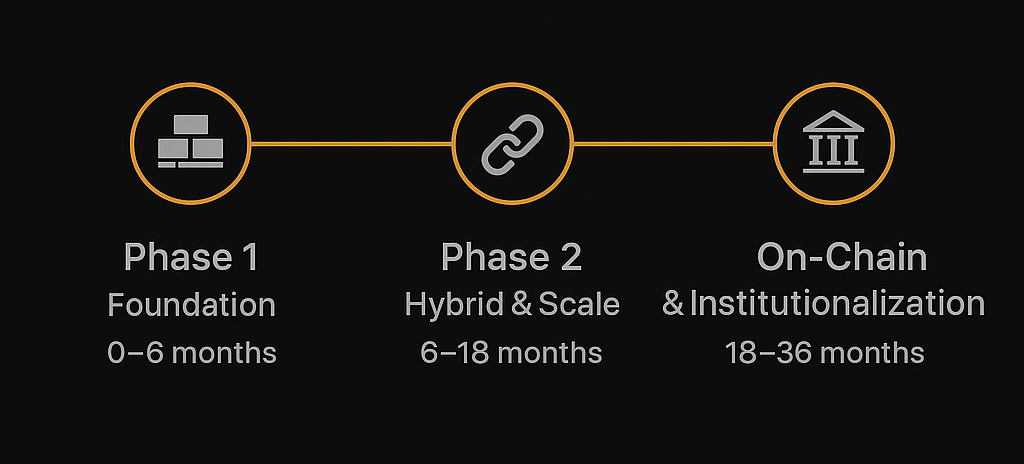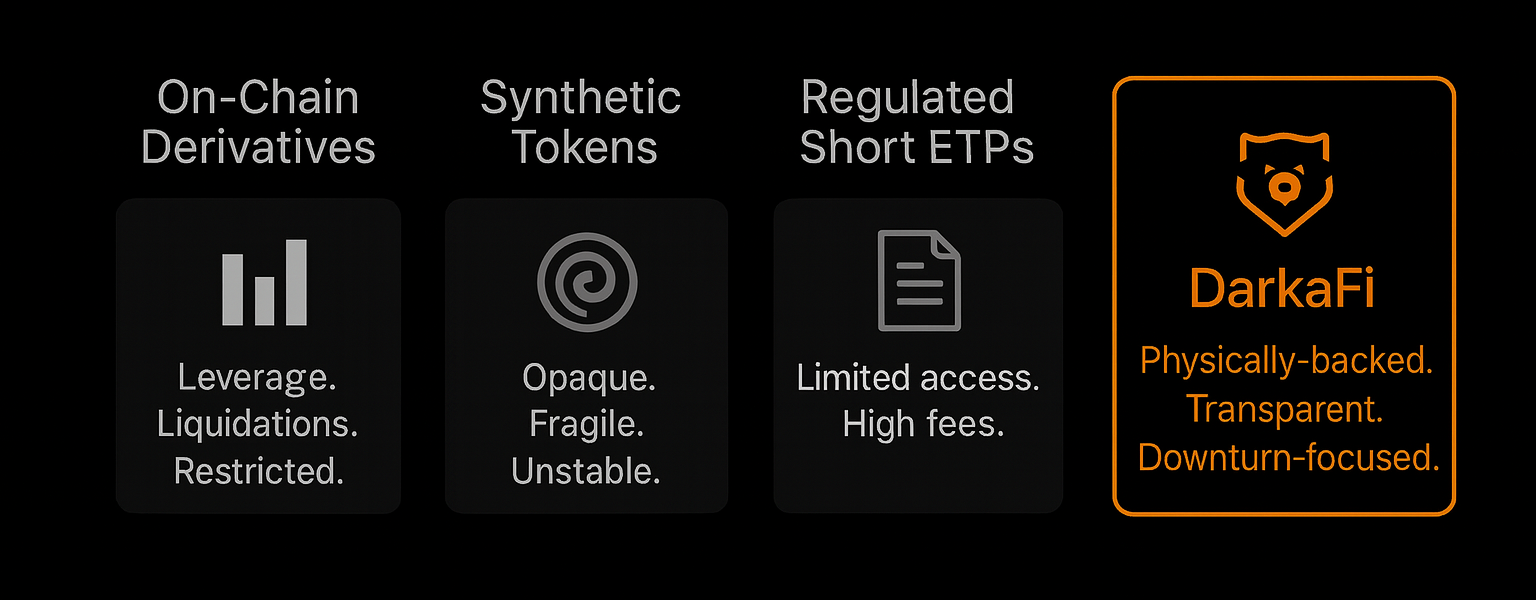This Litepaper serves as an early overview of DarkaFi’s vision and design. It is intended to share the guiding principles, methodology, and roadmap behind our launch of shortOne vaults—the first step in building a protocol designed to thrive in downturns.
It is not a final or comprehensive document. An official Whitepaper will be released soon after short vault products are available to the public. That Whitepaper will provide deeper technical specifications, tokenomics, governance structures, and long-term plans in full detail.
For now, this Litepaper should be read as a foundational outline—a window into the purpose and mechanics of DarkaFi, and an invitation to early supporters to understand the mission and join us as we build.
DarkaFi is the first protocol built to thrive in downturns. While most of DeFi is designed to prosper only in rising markets, DarkaFi focuses on the other side of the cycle: downturns, corrections, and crashes. Our mission is to make safe, accessible downside protection a core building block of decentralized finance.
At the heart of DarkaFi are physically-backed short tokens and vaults. Unlike synthetic or leveraged derivatives that dominate today’s landscape—and are often inaccessible or outright prohibited for many users—our products are grounded in real borrow, sell, and rebalance mechanics. This approach makes them transparent, resilient, and potentially more compliant for broader accessibility.
The need is clear. Downturns are not exceptions; they are inevitable phases of every market. Yet DeFi today offers very few robust tools to profit from or hedge against them. Traders, institutions, and everyday users are left vulnerable when prices fall, unable to manage risk without resorting to opaque or inaccessible instruments. DarkaFi fills this gap by becoming the downturn infrastructure layer of crypto: a place where investors can not only survive bear markets but thrive in them.
Crypto markets are inherently volatile. Periods of rapid growth are often followed by sharp corrections, and downturns are not rare anomalies but an inevitable feature of every market cycle. For traders and investors, these phases bring not only uncertainty but also significant risk exposure.
Despite this reality, DeFi today offers very few effective ways to manage or profit from falling markets. The limited short products that do exist are typically synthetic in nature, reliant on derivatives, or structured with leverage. These products are often inaccessible to U.S. users due to regulatory restrictions and, for many participants, they remain overly complex and opaque.
As a result, most of DeFi is fundamentally built for bull markets. Protocols thrive when assets appreciate, but they falter when prices decline. There is little in the way of robust, transparent, and user-friendly downside protection. This leaves both individuals and institutions exposed to unnecessary risk, with no clear way to hedge during downturns.
DarkaFi exists to close this gap by making downturn protection a first-class feature of decentralized finance.
DarkaFi is building what DeFi has been missing: a downturn infrastructure layer. Instead of treating market declines as an afterthought, DarkaFi makes them the foundation of its design.
At launch, this comes in the form of physically-backed short tokens and vaults. Unlike synthetic instruments or leveraged derivatives, these products operate through clear mechanics: collateral is deposited, assets are borrowed and sold, and positions are maintained through an ongoing process of rebalance. This creates short exposure that is both real and transparent, giving users confidence in how value is created and preserved.
By design, these vaults function as hedging instruments—tools to manage risk in turbulent markets. They are built to be safe, accessible, and intuitive, avoiding the opacity and complexity that keep existing products out of reach for many users. Guardrails such as collateral ratios and buffer mechanisms ensure stability, while share-based accounting makes performance clear to depositors.
Importantly, DarkaFi is not just for active traders. Institutions, funds, and long-term holders can use these vaults to protect portfolios against downturns, smooth returns, and preserve capital. For the first time, decentralized finance will have infrastructure that doesn’t just survive bear markets, but thrives in them.

When a user deposits USDC into the vault, they receive short tokens. Each token represents a share of the vault and directly corresponds to the vault’s Net Asset Value (NAV) per share. As the vault operates, the NAV per share changes to reflect asset prices, debt levels, collateral, and proceeds. This makes short tokens a transparent, tradable claim on the vault’s performance.

Objective: Launch a controlled, production-grade starter set of off-chain ShortOne vaults to validate mechanics, dashboards, and ops.
What ships
Success criteria
Gate to Phase 2
Objective: Transition from “controlled off-chain” to hybrid on/off-chain with verifiable data paths and broader access.
What ships
Operations & compliance
Success criteria
Gate to Phase 3
Objective: Deliver a full on-chain vault suite with institution-grade controls and distribution.
What ships
Assurance & governance
North-star outcomes
DarkaFi introduces a layered token system designed to reward early supporters, deliver predictable downturn rewards, and provide long-term governance and utility.
Founder Tokens (FT)
Founder Tokens grant early access to products and benefits reserved for the first supporters of DarkaFi. Holders are recognized as core contributors, gaining exclusive entry into the initial ShortOne vaults and receiving tailored rewards tied to the protocol’s early growth.
Bear Bonds
Bear Bonds are designed for predictable yield during downturns. They channel value captured from falling markets into stable, transparent reward streams, offering users a dependable way to benefit from volatility.
DarkCoin (DC)
DarkCoin is engineered as the ultimate hedge token. Its design ties directly to the performance of DarkaFi’s short vaults: profits and losses from these vaults fuel buyback and sellback mechanisms that place inverse pressure on DC’s supply and price. In bull markets, sellbacks provide stability; in bear markets, buybacks amplify value capture. This makes DC not just a utility token, but a systematic hedge against market cycles—positioning it as the centerpiece of DarkaFi’s downturn infrastructure.

Most of today’s market tools for downside exposure fall into one of three categories—each with significant shortcomings that leave users vulnerable. DarkaFi addresses these gaps by offering a transparent, physically-backed, and downturn-focused alternative.
On-Chain Derivatives
Derivative products dominate shorting in DeFi, but they are effectively prohibited for U.S. users. They rely heavily on leverage, expose participants to cascading liquidations, and fail regulatory tests that restrict global accessibility.
Synthetic Tokens
Synthetic representations of short exposure exist, but they are opaque and unstable. Their peg mechanisms depend on fragile incentives or secondary collateral pools that can collapse under stress. What looks like a hedge often lacks the reliability of real borrow-and-sell mechanics.
Regulated Short ETPs
Exchange-traded products that provide short exposure exist in traditional markets, but they are limited to select venues, often carry high fees, and lack the composability of DeFi. They remain inaccessible to many crypto-native participants and cannot integrate seamlessly into decentralized workflows.
DarkaFi’s Differentiator
DarkaFi stands apart as the first downturn infrastructure layer. Its vaults are physically-backed through borrow-and-sell mechanics, transparent in NAV-per-share tracking, and broadly accessible. By design, they turn downturns from periods of loss into opportunities for stability and growth.
Why Now?
Every market cycle carries both euphoria and collapse. Yet in DeFi, only one side of the cycle has been built for. Bull markets are celebrated, while downturns are treated as accidents to be endured. But downturns are not mistakes—they are part of the rhythm of markets. Ignoring them leaves users vulnerable and unprepared.
Why DarkaFi?
DarkaFi is built on the belief that downturns deserve their own infrastructure. By creating physically-backed short vaults and hedge tokens designed to capture value when prices fall, DarkaFi transforms volatility into strategy. We are not chasing speculation—we are building tools that make risk itself investable.
Our Mission
To establish the first dedicated platform for downside protection in DeFi, a system that thrives when others falter. We aim to give every trader, every treasury, and every institution the power to hedge, defend, and prosper in downturns.
Our Vision
In three years, DarkaFi will surpass $500M in assets under management and secure a place among the top 50 DeFi protocols. But more than rankings, the vision is to reshape how the industry views risk—not as an obstacle, but as a frontier of opportunity.